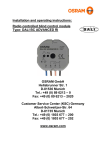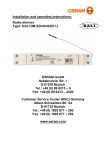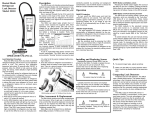Download Installation and operating instructions: Radio-control
Transcript
Installation and operating instructions:
Radio-control combined sensor
Type: DALI LS/PD ADVANCED
OSRAM GmbH
Hellabrunner Str. 1
D-81536 Munich
Tel.: +49 (0) 89 6213 – 0
Fax: +49 (0) 89 6213 – 2020
Customer Service Center (KSC) Germany
Albert-Schweitzer-Str. 64
D-81735 Munich
Tel.: +49 (0) 1803 677 – 200
Fax: +49 (0) 1803 677 – 202
www.osram.com
Page 2
Installation instructions: Combined Sensor DALI LS/PD ADVANCED
Contents
1. Function overview.........................................................Page 4
2. Activating the sensor/inserting the batteries .................Page 5
3. Programming in the DALI ADVANCED central unit ......Page 6
4. Installation.....................................................................Page 7
5. Detection area and shield .............................................Page 8
6. Adjustment of the sensor ..............................................Page 9
7. Lighting control/setpoint adjustment .............................Page 9
8. Notes on radio operation ..............................................Page 11
9. Technical data ..............................................................Page 12
Installation instructions: Combined Sensor DALI LS/PD ADVANCED
Page 3
1.
Function overview
The radio-control combined sensor maximises energy savings by combining presence-controlled
lighting with daylight-dependent control.
It comprises a passive infrared sensor (PIR) which reacts to the movement of heat and therefore to
the presence of people, and also a light-sensitive resistor that measures the luminance in a defined
detection area. The sensor forwards this dual information (brightness and presence) to the DALI
ADVANCED central unit. The data is evaluated in the central unit and the lighting system controlled
accordingly.
When movement is detected, the combined sensor switches the luminaires of the relevant group on
and automatically starts controlling the lighting level. Lighting control remains active as long as the
sensor detects movement. When movement is no longer detected, the lighting system is switched off
after a user-definable delay. The lighting system is also switched off if a brightness threshold is
exceeded.
The combined sensor consists of the following:
Abb. A
Sensor window with LED below it
Decorative ring
Base plate
Light sensor
Under the decorative ring
there are three controls:
Sensitivity of the motion detector
Delay for switching off the system
if no movement is detected
Not used here.
(The setpoint value is assigned
via the manual programming unit)
Page 4
sens
Abb. B
max
time
min
1h
lux
2 min
Installation instructions: Combined Sensor DALI LS/PD ADVANCED
2.
Activating the sensor/inserting the batteries
Battery type:
The combined sensor is operated on four AAA (LR 03) alkaline batteries (not included). Do not use
zinc/carbon batteries (R 03) or rechargeable batteries.
To avoid damaging the electronics through electrostatic discharge, you must comply with the safety
precautions for electrostatically sensitive devices when changing the battery.
Inserting (replacing) the batteries
1. Detach the combined sensor from the base plate by turning the unit approx. 45° clockwise (Fig. C).
2. Remove any old batteries. Wait about 2 minutes before inserting the new batteries. Make sure they
are the right way round (Fig. D).
3. Attach the combined sensor to the base plate again by turning the unit about 45° anticlockwise until
it clicks in place.
4. For the first 30 seconds after batteries are inserted the combined sensor sends special
programming telegrams.
LR03
AAA
LR03
AAA
LR03
AAA
Fig. D
LR03
AAA
Fig. C
45°
Flat battery indicator:
The LED integrated behind the sensor window (Fig. A1) can only be seen in darkness. It flashes three
times whenever a transmission is made.
If the LED flashes about ten times, this indicates that the batteries are almost flat (LowBatt) and
have to be replaced.
Important.
Keep batteries away from children. If a battery is swallowed, seek medical attention immediately.
Replace the batteries with ones of the same type.
Old batteries should be removed immediately and disposed of properly.
Installation instructions: Combined Sensor DALI LS/PD ADVANCED
Page 5
3.
Programming in the DALI ADVANCED central unit
The combined sensor must be programmed for lighting control in the central unit so that the central
unit can identify the sensor as part of its system.
The actual function of the sensor is assigned to the central unit by the manual programming unit
(MPU).
A combined sensor can only be assigned to one group of the lighting control system.
A maximum of eight combined sensors or light sensors can be integrated in the system.
Procedure
1. Remove the batteries from the combined sensor.
2. On the manual programming unit (MPU), start the "radio startup" programming mode.
3. Put the batteries back in (if programming, wait for 2 minutes before doing so). The sensor will now
transmit special programming telegrams for approx. 30 seconds, to which the manual programming
unit will react ("presence sensor found"). On the MPU, enter the number of the luminaire group to
be controlled by this sensor.
4. Terminate the radio startup procedure on the MPU.
This completes the programming process.
Notes:
When you enter the group on the MPU the message "programming..." will appear. This message does
not disappear until the light sensor stops sending programming telegrams (up to 30 seconds after the
battery has been inserted). During this time, no other functions can be performed by the system.
We recommend that you label the combined sensor with the device number indicated on the MPU and
enter this number in the documentation for the lighting system.
Deleting the device in the DALI ADVANCED central unit:
Programmed devices can be deleted via the MPU
programming unit.
Page 6
see the operating instructions for the manual
Installation instructions: Combined Sensor DALI LS/PD ADVANCED
4.
Installation
Electrical equipment may only be installed by qualified electricians.
The combined sensor is mounted on the ceiling and monitors an area directly beneath it (Fig. B).
The brightness value measured on the combined sensor comprises the reflected artificial light
daylight and depends on the reflective properties of the surface (Fig. C).
Fig. B
1,7 m
and
Fig. C
2,5 m
Make sure the sensor is positioned so that sunlight does not shine directly on it. If required, the
detection area can be restricted by means of the shield supplied (see "4. Detection area and shield").
Do not install the combined sensor in the immediate vicinity of any heat sources (such as luminaires or
radiators), fans or ventilation shafts. Lamps that are cooling down and air movements caused, for
example, by open windows may be detected, and lead to unwanted activation of the lighting system.
Installation:
Abb. D
1. Attach the base plate to the ceiling with the screws provided
(Fig. D ).
2. Turn the combined sensor anticlockwise through approx. 45°
on the base plate until it clicks into place.
Important:
Do not attach the combined sensor to the base plate until you have inserted the batteries and
programmed the sensor in the central unit.
Installation instructions: Combined Sensor DALI LS/PD ADVANCED
Page 7
5.
Detection area and shield
The motion sensor has a detection angle of 360°. The PIR sensor operates with six detection levels
and 80 lenses. If installed at a height of 2.5 m, the sensor will have a detection area approx. 5 m in
diameter at desk level (approx. 80 cm), Fig. E. The diameter at floor level is approx. 8 m.
The detection area is increased if the sensor is mounted higher, but this reduces the detection density
(Fig. F) and the sensitivity of the sensor.
Fig. E
Fig. F
1m 3m 5m
0
2m 4m
2,50
0,8 m
4
3
2
1
0
4m
Shield
You can use the shield supplied to mask off areas that you do not wish the sensor to cover. The shield
is simply placed over the sensor window. Trim the shield only along the lines marked (Fig. G).
The following information relates to an installation height of approx. 2.50 m, giving a detection
field diameter of approx. 8 m at floor level.
Trimming changes the diameter of the detection field at floor level as follows:
Complete shield, area I:
Area II trimmed:
Areas II and III trimmed:
No shield:
Page 8
∅ approx. 2.20 m
∅ approx. 4.00 m
∅ approx. 6.00 m
∅ approx. 8.00 m
Abb. G
Installation instructions: Combined Sensor DALI LS/PD ADVANCED
6.
Adjustment of the sensor
To change the delay or the sensitivity you must first remove the decorative ring (Fig. H
combined sensor.
This gives you access to the following controls:
) from the
Abb. H
"sens":
Use this control to adjust the sensitivity of the motion detector.
First, set the control to maximum sensitivity.
If the sensor is too sensitive, turn the control back toward "min".
Note: At minimum sensitivity the presence sensor
is effectively switched off.
sens
max
min
time
1h
lux
2 min
"time":
This control enables you to make fine adjustments
to the switch-off delay between about 2 minutes and 1 hour.
The mid-position corresponds to about 15 minutes.
If no movement is detected during the delay time,
the relevant group will be switched off.
Not used (the setpoint value is determined on the manual programming unit)
When you have finished making the adjustments, replace the decorative ring. It must click into place.
7.
Lighting control/setpoint adjustment
As already mentioned, a group is assigned to the combined sensor when it is programmed in the
central unit. The luminaires of this group will then be switched and controlled by the sensor.
This group must also be assigned at least one channel button on a wall-mounted or hand-hald
transmitter for operating the lighting controls. Train the relevant channel button using the manual
programming unit and then assign this button to the group to be controlled ("control of group XX", see
operating instructions for the manual programming unit).
Setting the brightness setpoint
The luminance measured on the combined sensor
(Fig. I ) comprises the reflected artificial light
and daylight and depends on the reflective properties
of the surface .
Abb. I
It is transmitted as a brightness value at regular
intervals to the central unit for evaluation.
If the setpoint is changed, this brightness value
is stored in the central unit as the setpoint for lighting control.
Changing the setpoint
Select "Regulation" in the "Lighting Control" menu on the manual programming unit. Enter the number
of the group to be controlled. You can now change the setpoint. Adjust the lighting to the required
setting and select "Change Setpoint". The message "waiting for brightness value.." will appear. The
next brightness value that the combined sensor sends is stored as the new setpoint in the central unit
("Setpoint changed"). This process may take up to 90 seconds.
Activate lighting control by switching the "Regulation" option to "ON".
Note: As long as there is a radio link between the central unit and the manual programming unit,
lighting regulation will not be carried out.
Installation instructions: Combined Sensor DALI LS/PD ADVANCED
Page 9
Lighting control
Lighting control is active if the relevant group has been switched on because movement has been
detected or a programmed channel button on a wall-mounted or hand-held transmitter has been
pressed (short press). The lighting system is switched to 100 % and the brightness is then adjusted to
the setpoint stored in the central unit. If the measured brightness value exceeds the current brightness
setpoint at the minimum dimmer setting for the luminaires by a considerable margin, the relevant
group is automatically switched off. The group will also be switched off if no movement is detected
during the time set on the "time" control. The lighting system can be switched off manually at any time
by pressing a suitably programmed channel button.
Note: When the system is operated for the first time and after any interruption to the power supply the
assigned group must be switched on by briefly pressing a suitably programmed channel button. Only
then will movement detection and lighting control be available.
Please note the following:
If the lighting system was switched off because the brightness level was too high
If movement is detected the lighting control will automatically switch the lighting system back on if the
measured brightness is below the setpoint (e.g. if the weather becomes overcast). If the delay time
has expired because there has been no movement the lighting system will not be switched on again.
If the lighting system was switched off because of a lack of movement
As soon as movement is detected again the lighting system is switched on at 100% and lighting
control is activated.
If the lighting system was switched off by means of a programmed channel button
Only after the delay time has expired will the lighting system be switched on again in response to
movement. This ensures that when someone switches the lighting off manually (intentionally) it is not
automatically switched on again because the person is still in the room.
Terminating control
If the lighting level of the regulated group is changed (faded up or down) using a programmed channel
button on a wall-mounted or hand-held transmitter, lighting control is terminated and the lighting value
set manually is retained. The same applies when a lighting scene involving the regulated group is
selected. Control is restarted if a suitably programmed channel button is used to switch the relevant
group on or to maximum brightness (short press).
Note:
If lighting control is terminated by manually adjusting the lighting system, the lighting system
will not be switched off automatically if no movement is detected. In this case, use one of the
suitably programmed channel buttons to switch the lighting system off manually when you
leave the room.
Page 10
Installation instructions: Combined Sensor DALI LS/PD ADVANCED
8.
Notes on radio operation
A non-exclusive transmission path is used for radio transmission, which means that
interference cannot be ruled out.
Radio transmission is not suitable for safety applications, such as emergency shutdown or
calls to the emergency services.
The range of the transmitter (up to 100 m in the open) depends on the height at which it is installed
and on the nature of the building:
Dry material
Wood, plaster, plasterboard
Brick, MDF
Reinforced concrete
Metal, metal grating, aluminium
cladding
Penetration
approx. 90 %
approx. 70 %
approx. 30 %
approx. 10 %
Fig. L
Notes on radio operation
- This radio system may only be connected to other communication networks if this does not infringe
the relevant national laws.
- This radio system may not be used for communicating beyond property boundaries.
- If operated in Germany, the regulations contained in Official Bulletin Vfg 73/2000 must be met.
- If used as specified, this device complies with the requirements of the R&TTE directive (1999/5/EU).
A complete conformity declaration can be found on the internet at: www.osram.com
The combined sensor may be operated in all EU and EFTA states.
Installation instructions: Combined Sensor DALI LS/PD ADVANCED
Page 11
9.
Technical data
Rated voltage:
6 V DC
Batteries:
4 x 1.5 V AAA (LR03) alkaline
(Do not use zinc/carbon batteries (R 03) or rechargeable batteries)
Transmission frequency:
433.42 MHz
Modulation:
ASK
Range:
max. 100m (in the open)
Radio codes:
> 1 billion
Detection angle:
360°
Nominal range
- at desk level:
- at floor level:
approx. ∅ 5m
approx. ∅ 8m
Installation height for nominal range:
2.5m
Delay time:
approx. 2 min to 1 h
Brightness:
approx. 3 - 2000 lx
Temperature range:
0°C to 45°C
Type of protection:
IP 20
Dimensions
- Diameter:
- Height:
103 mm
42 mm
Digital Addressable Lighting Interface
The international digital interface standard for the lighting industry
Date 13.09.02 / Combined Sensor ADVANCED Version 1.0
Subject to change without notice. Errors and omission excepted.
Page 12
Installation instructions: Combined Sensor DALI LS/PD ADVANCED























